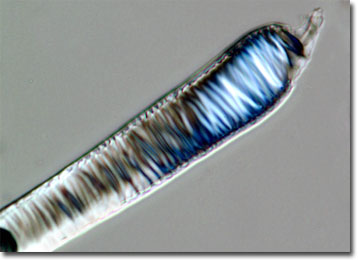Differential Interference Contrast Image Gallery
Kapok Fibers
Kapok fiber is often referred to as Java cotton because of its texture and its function as an important export from the Indonesian island of Java. The silky material is extracted from the seedpods of the ceiba tree, which is primarily found in the porous volcanic soil of Asian countries.

In order to prepare kapok fiber for export, the material is removed from the pod by hand and then dried and separated from the seeds. Though too brittle and inflexible to be spun into thread, importers have found other uses for the substance. Since kapok fibers are cellulose tubes that contain a small quantity of air, they are extremely buoyant and can support up to 30 times their own weight in water. The material, therefore, is often used in life preservers and other water-safety gear. Due to its other commendable qualities, such as its non-allergic, non-toxic, and odorless nature, kapok fiber is also popular for stuffing items like pillows, mattresses, and sleeping bags.
The ceiba tree, which belongs to the family Bombacaceae, is not only important for the fiber it provides. Other parts of the tree are manufactured into other products, such as soap and edible oil. Moreover, numerous animals, including bats, eagles, tree frogs, and toucans, find shelter and nourishment from ceibas, and to the Mayans they held religious significance. Awed by the tremendous heights they can reach, Mayans believed that the souls of the dead climbed into heaven through the branches of a mythical ceiba tree.
